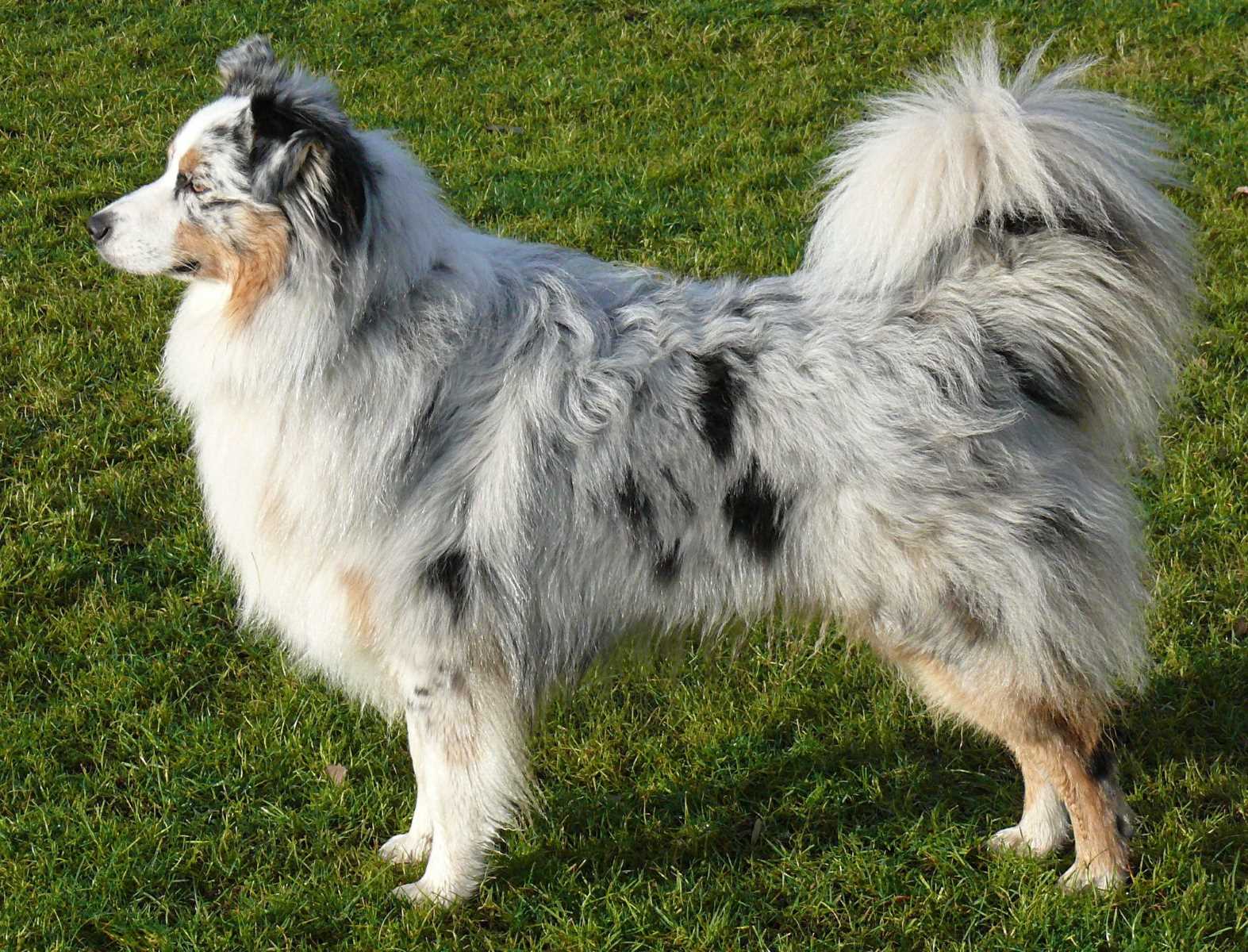Home>Pets & Animals>The Shocking Reason Australian Shepherds Get Their Tails Docked!


Pets & Animals
The Shocking Reason Australian Shepherds Get Their Tails Docked!
Published: February 17, 2024
Learn the surprising truth about why Australian Shepherds have their tails docked. Discover the history and controversy behind this practice in the world of pets and animals.
(Many of the links in this article redirect to a specific reviewed product. Your purchase of these products through affiliate links helps to generate commission for Regretless.com, at no extra cost. Learn more)
Table of Contents
Introduction
Australian Shepherds, renowned for their intelligence, agility, and unwavering loyalty, have captured the hearts of dog enthusiasts worldwide. However, behind their endearing demeanor lies a controversial practice deeply rooted in their history – tail docking. This practice, which involves the partial amputation of the tail, has sparked debates among veterinarians, breeders, and dog lovers, prompting a closer examination of its origins and implications.
The decision to dock a dog's tail is often influenced by a combination of tradition, aesthetics, and practical considerations. For Australian Shepherds, a breed historically valued for its herding abilities, tail docking was initially believed to serve a functional purpose. As we delve into the history of this practice, we will uncover the intricate relationship between the Australian Shepherd's working background and the contentious tradition of tail docking.
In this article, we will explore the multifaceted nature of tail docking, shedding light on the impact it has on Australian Shepherds. By examining the controversy surrounding this practice and considering alternative solutions, we aim to provide a comprehensive understanding of the issue at hand. Through this exploration, we hope to foster greater awareness and empathy for these remarkable canine companions.
The History of Tail Docking
The practice of tail docking dates back centuries and is deeply intertwined with the historical roles and functions of various dog breeds. While the precise origins of tail docking are somewhat elusive, evidence suggests that it was initially performed for practical purposes rather than cosmetic reasons. In the case of the Australian Shepherd, this practice can be traced back to its origins as a working dog with a rich heritage in herding livestock.
Historically, tail docking was believed to serve a functional purpose, particularly for herding dogs. The primary rationale behind this practice was to minimize the risk of tail injuries while the dogs were engaged in their demanding work. Australian Shepherds, known for their agility and tireless work ethic, were often required to navigate rugged terrain and confront formidable livestock. In such environments, the risk of tail injuries, such as fractures or lacerations, was a genuine concern. By shortening the tail, it was believed that the dogs could avoid potential harm and maintain their mobility and agility during herding activities.
Furthermore, the historical context of tail docking reveals a practical dimension that extended beyond the immediate safety of the dogs. In the early days of herding, when Australian Shepherds played a pivotal role in managing livestock on expansive ranches and farms, the absence of a protruding tail was thought to minimize the likelihood of it being caught or injured by livestock. This was particularly relevant in environments where the dogs worked closely with larger animals, such as cattle and horses, and needed to maneuver swiftly and deftly to fulfill their herding duties effectively.
Over time, the practice of tail docking evolved from a functional necessity to a customary tradition, perpetuated by cultural norms and breed standards. Despite the shift in perception from practicality to aesthetics, the historical context of tail docking underscores the intricate relationship between the Australian Shepherd's working background and the origins of this controversial practice.
As we delve into the historical underpinnings of tail docking, it becomes evident that understanding the origins of this practice is crucial for evaluating its contemporary implications and considering alternative approaches that align with the evolving roles and welfare of Australian Shepherds.
The Australian Shepherd's Working Background
The Australian Shepherd, despite its name, has a rich history deeply rooted in the American West. Bred to be versatile and hardworking, these dogs played an integral role in the development of ranching and herding practices in the United States. Their working background is a testament to their exceptional intelligence, agility, and unwavering dedication to their tasks.
Originally developed to assist Basque shepherds in managing livestock, Australian Shepherds demonstrated remarkable herding instincts and an innate ability to adapt to diverse terrains and climates. Their exceptional work ethic and versatility made them indispensable companions on ranches and farms, where they excelled in herding not only sheep but also cattle, goats, and other livestock. Their agility and keen sense of awareness allowed them to navigate challenging landscapes with precision and control, earning them a reputation as reliable and efficient herding dogs.
The demanding nature of their work required Australian Shepherds to be alert, responsive, and capable of making quick decisions in dynamic environments. Whether it was guiding a flock through rugged terrain or assisting in the management of livestock in confined spaces, these dogs exhibited a remarkable blend of athleticism and intelligence that set them apart as exceptional working partners.
Furthermore, Australian Shepherds' dedication to their herding duties often extended beyond the confines of the ranch. They accompanied ranchers on long cattle drives, enduring grueling journeys across vast expanses of land. Their unwavering loyalty and tireless work ethic endeared them to those who relied on their assistance, solidifying their status as invaluable working companions.
The Australian Shepherd's working background, characterized by its integral role in herding and ranching, underscores the breed's deep-rooted connection to the American frontier. Their contributions to the development of Western ranching traditions and their unwavering commitment to their duties have left an indelible mark on the history of the American West.
As we delve into the historical context of the Australian Shepherd's working background, it becomes evident that the breed's heritage is intrinsically linked to the evolution of herding practices in the United States. This legacy serves as a poignant reminder of the breed's enduring legacy as a quintessential working dog, embodying the spirit of dedication, adaptability, and resilience that has defined its role in shaping the American frontier.
The Controversy Surrounding Tail Docking
The practice of tail docking has ignited passionate debates within the veterinary community, among dog breeders, and among concerned pet owners. At the heart of the controversy lies the ethical and welfare considerations surrounding the procedure, particularly in the context of Australian Shepherds and other working dog breeds.
Critics of tail docking argue that the procedure, when performed for non-therapeutic reasons, constitutes an unnecessary alteration to the natural form of the dog. They contend that the inherent value of a dog's tail extends beyond aesthetics and serves vital communicative and behavioral functions. The tail, they argue, is an essential means of expression, enabling dogs to convey emotions, intentions, and social cues to other animals and humans. Additionally, the tail plays a crucial role in maintaining balance and coordination, especially during agile movements and intricate maneuvers, traits for which Australian Shepherds are renowned.
Furthermore, opponents of tail docking emphasize the potential for acute and chronic pain associated with the procedure, as well as the risk of postoperative complications and adverse behavioral effects. They argue that the amputation of the tail, a highly innervated structure, can lead to persistent discomfort and alter the dog's sensory perception, potentially impacting its overall well-being and quality of life.
Advocates of tail docking, on the other hand, often cite historical precedent, breed standards, and perceived functional benefits as justifications for the practice. They argue that for working dogs such as Australian Shepherds, tail docking may mitigate the risk of tail injuries in demanding environments, thereby safeguarding the dogs' ability to perform their tasks effectively. Additionally, proponents contend that tail docking aligns with established breed standards and traditions, contributing to the preservation of the breed's distinctive appearance and facilitating its recognition in conformation shows and working trials.
As the debate rages on, the welfare of Australian Shepherds remains at the forefront of the discussion. The controversy surrounding tail docking underscores the need for a nuanced and evidence-based approach that considers the breed's historical context, behavioral needs, and overall welfare. In the quest for a resolution, the voices of veterinarians, ethologists, breeders, and dedicated dog enthusiasts converge in search of solutions that prioritize the well-being and integrity of these remarkable canine companions.
The Impact of Tail Docking on Australian Shepherds
The impact of tail docking on Australian Shepherds extends beyond the physical alteration of their anatomy, encompassing potential implications for their well-being and behavior. While proponents of tail docking often emphasize its purported benefits for working dogs, including Australian Shepherds, it is essential to consider the broader impact of this practice on the dogs' overall quality of life.
One notable consequence of tail docking is the potential for acute and chronic pain experienced by the dogs during and after the procedure. The amputation of the tail, a structure rich in nerve endings, can lead to persistent discomfort and sensory alterations. This may affect the dogs' mobility, coordination, and overall comfort, potentially compromising their ability to engage in natural behaviors and activities.
Moreover, the absence of a tail may impede the dogs' communicative abilities and social interactions. Tails serve as vital tools for dogs to express emotions, convey intentions, and communicate with other animals and humans. For Australian Shepherds, known for their keen intelligence and astute awareness, the loss of this means of non-verbal communication may impact their social dynamics and ability to navigate complex social cues within their working and domestic environments.
The psychological impact of tail docking on Australian Shepherds cannot be overlooked. The procedure may lead to behavioral changes, including heightened stress, anxiety, and altered coping mechanisms. The dogs' ability to adapt to new stimuli and situations may be influenced by the absence of their natural tail, potentially affecting their overall resilience and emotional well-being.
Furthermore, the implications of tail docking extend to the dogs' physical agility and balance, traits for which Australian Shepherds are renowned. The tail plays a crucial role in maintaining stability and coordination, especially during agile movements and intricate maneuvers. The absence of a tail may compromise the dogs' ability to navigate varied terrain and perform their herding duties with the same level of precision and agility.
In evaluating the impact of tail docking on Australian Shepherds, it is imperative to consider the multifaceted nature of the dogs' well-being, encompassing physical, behavioral, and emotional dimensions. As the debate surrounding this practice continues, a comprehensive understanding of its implications for the breed's welfare is essential in shaping informed decisions and promoting the holistic health and integrity of these remarkable canine companions.
Alternative Practices and Solutions
In response to the ongoing debate surrounding tail docking in Australian Shepherds, there is a growing emphasis on exploring alternative practices and solutions that prioritize the breed's welfare while addressing concerns related to tail injuries and breed standards. These alternatives seek to reconcile the historical context of tail docking with contemporary understandings of canine welfare and ethical considerations.
One alternative approach involves the promotion of breed-specific guidelines that advocate for the preservation of the natural tail in Australian Shepherds. By emphasizing the intrinsic value of the tail as a vital means of communication, balance, and expression, these guidelines underscore the importance of respecting the breed's innate anatomical features. This approach aligns with a broader movement towards embracing the natural characteristics of dog breeds, recognizing the significance of tail preservation in maintaining the dogs' physical and behavioral integrity.
Another avenue for consideration revolves around advancements in injury prevention and management techniques. With a focus on proactive measures to safeguard the well-being of Australian Shepherds, efforts are underway to develop innovative protective gear and training protocols tailored to the specific needs of working dogs. These initiatives aim to mitigate the risk of tail injuries without resorting to surgical interventions, thereby promoting the dogs' safety and comfort while fulfilling their herding duties.
Additionally, there is a growing emphasis on education and awareness campaigns aimed at fostering responsible stewardship of Australian Shepherds and other working dog breeds. By equipping owners, breeders, and the broader dog-loving community with knowledge about the historical context of tail docking, its potential implications, and alternative approaches, these initiatives seek to promote informed decision-making and ethical considerations in the care and management of these remarkable canine companions.
Furthermore, the exploration of non-invasive alternatives, such as behavioral enrichment and environmental modifications, holds promise in addressing the behavioral and psychological needs of Australian Shepherds. By creating enriching environments that cater to the dogs' innate instincts and cognitive abilities, while also providing outlets for natural behaviors, such as interactive play and mental stimulation, these approaches contribute to the overall well-being and fulfillment of the dogs without resorting to surgical alterations.
In embracing these alternative practices and solutions, the welfare of Australian Shepherds is prioritized, reflecting a commitment to honoring the breed's heritage while embracing progressive approaches that align with contemporary understandings of responsible dog care. By fostering a culture of empathy, informed decision-making, and innovation, these alternatives pave the way for a future where the well-being and integrity of Australian Shepherds are upheld with the utmost care and consideration.
Conclusion
In conclusion, the practice of tail docking in Australian Shepherds encapsulates a complex interplay of historical traditions, functional considerations, ethical debates, and the overarching imperative of prioritizing the breed's welfare. The historical origins of tail docking, rooted in the breed's working background and the perceived need for injury prevention, underscore the intricate relationship between the practice and the Australian Shepherd's heritage as a versatile and dedicated herding dog.
The controversy surrounding tail docking reflects a broader discourse on the ethical treatment of animals and the evolving understanding of canine welfare. While proponents and critics offer contrasting perspectives, the central focus remains on the well-being of Australian Shepherds and the implications of tail docking on their physical, behavioral, and emotional health. The multifaceted impact of tail docking, encompassing potential pain, altered communication, and compromised agility, underscores the need for a comprehensive and empathetic approach that acknowledges the breed's intrinsic qualities and needs.
As we navigate this complex terrain, the exploration of alternative practices and solutions emerges as a pivotal avenue for promoting the welfare of Australian Shepherds. By advocating for breed-specific guidelines, embracing advancements in injury prevention, prioritizing education and awareness, and fostering non-invasive alternatives, we can chart a path towards a future where the breed's well-being is safeguarded without compromising its historical legacy.
Ultimately, the welfare of Australian Shepherds hinges on a harmonious integration of tradition, empathy, and evidence-based practices. By honoring the breed's remarkable heritage while embracing progressive approaches that align with contemporary understandings of responsible dog care, we can cultivate a culture of stewardship that places the well-being and integrity of Australian Shepherds at the forefront.
In the spirit of empathy and informed decision-making, we embark on a journey towards a future where the remarkable qualities and contributions of Australian Shepherds are celebrated and preserved, ensuring that these exceptional canine companions continue to thrive in environments that honor their unique heritage and prioritize their holistic well-being.














